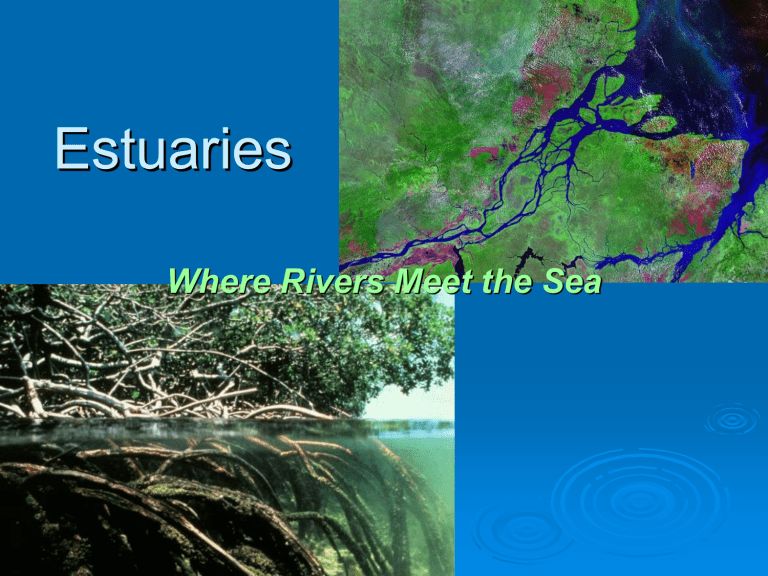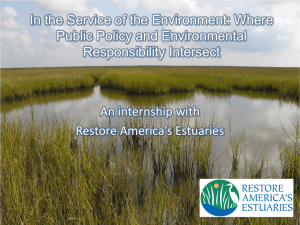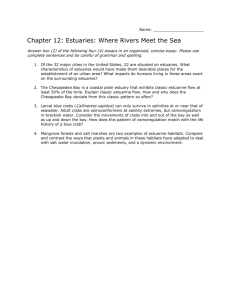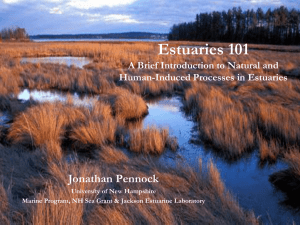
Estuaries Where Rivers Meet the Sea Rivers connect to ocean ➢ Estuaries are where the nutrient outflow of a river meets the ocean. ➢ Estuaries are incredibly productive – meaning lots of producers!! ➢ The cloudy water here in Galveston bay is NOT dirt!!! ➢ It is PRODUCERS Origins And Types of Estuaries ➢ Estuaries are semi-enclosed areas where fresh water and seawater meet and mix ➢ They therefore represent a close interaction between land and sea ➢ Estuaries are among the most productive environments on earth. ➢ Estuaries also rank among the environments most affected by humans Origins And Types of Estuaries ➢ Estuaries are scattered along the shores of all the oceans and vary widely in origin, type, and size ➢ They may be called lagoons, sloughs, or bays – such as Florida Bay ➢ Some oceanographers classify enclosed seas with restricted circulation, such as the Baltic and Black seas, as estuaries Origins And Types of Estuaries ➢ Many estuaries were formed when sea level rose because of the melting of ice at the end of the last ice age (18,000 years ago) ➢ The sea invaded lowlands and river mouths in the process ➢ These estuaries are called drowned river valleys or coastal plain estuaries ➢ They are the most common type of estuary Origins And Types of Estuaries ➢ Another ● type of estuary is the bar built estuary The accumilation of sediments along the coast builds up sand bars and barrier islands (found along coasts in the Gulf of Mexico) ➢ Other estuaries, such as San Francisco Bay in California, were created not because sea level rose but because the land sank – tectonic estuaries ➢ Fjords are estuaries where retreating glaciers cut deep, often spectacular, valleys alond the coast. The valleys were partially submerged when sea level rose, and rivers flowed into them estuaries Physical Characteristics of Estuaries ➢ Influenced by the tides and mixing of fresh and salt water, estuaries have a unique combination of physical and chemical characteristics ➢ These factors govern the lives of the organisms that live there. Physical Characteristics of Estuaries ➢ The salinity of estuaries fluctuates dramatically both from place to place and from time to time ➢ Salinity varies with depth as well ➢ Salt water being more dense sinks to the bottom and creates salt wedges ➢ Salt wedges move back and forth with the daily tides Salt Wedge Physical Characteristics of Estuaries ➢ In regions of little freshwater runoff and high evaporation the salinity of the water increases ➢ The average salinity for some locations like this – Laguna Madre, Texas coast – is over 50% in some areas, and may reach 100% in dry spells. These high salinity estuaries are called negative estuaries Living in Estuaries Coping with Salinity Fluctuations ➢ Living in an estuary is not easy, so few species have adapted to these conditions ➢ Maintaining the proper salt and water balance in cells and body fluids is one of the greatest challenges of organisms living in estuaries ➢ Most estuary organisms are marine organisms that can tolerate low salinity. Living in Estuaries Coping with Salinity Fluctuations ➢ Most estuary organisms are euryhaline species, that is, they tolerate a wide range of salinities. ➢ The relatively few stenohaline species, those that tolerate only a narrow range of salinities, are limited to the upper or lower ends of the estuary and rarely penetrate in the estuary proper ➢ Some live in brackish water, or water of intermediate salinity Living in Estuaries Coping with Salinity Fluctuations ➢ ➢ Soft-bodied estuarine animals, such as many molluscs and polychaete worms, often maintain osmotic balance simply by allowing their body fluids to change with the salinity of the water. These are called osmoconformers. Many fish, crabs, molluscs, and plochaete worms are instead osmoregulators. They keep the salt concentration of body fluids more or less the same regardless of the salinity of the water. ● ● ● When salinity of water is lower than that of their blood, they get rid of excess water and take-up solutes via active transport by the gills, kidneys, and other structures Anadromous fish: migrate from sea to spawn in freshwater Catadromous fish: migrate from fresh water to spawn in the sea Freshwater Inflows… Nutrients Sediments Salinity …By Definition Create and Sustain Estuaries Types of Estuarine Communities ➢ Several distinct communities are associated with estuaries ➢ One consists of the plankton, fishes, and other open water organisms that come in and leave with the tide ➢ Several other communities are permanent parts of the ecosystem Types of Estuarine Communities ➢ Open Water ➢ Mudflats ➢ Salt Marshes ➢ Mangrove Forests Types of Estuarine Communities: Open Water ➢ One of the reasons many of the world’s great cities developed around estuaries is the rich supply of fish and shellfish in or near estuaries ➢ Many species of commercially important fishes and shrimps use estuaries as nurseries ➢ 90% of the marine commercial catch in the northern Gulf of Mexico, for example, is of species that depend on estuaries at some point in their lives Types of Estuarine Communities: Mudflats ➢ ➢ ➢ ➢ ➢ ➢ ➢ The bottoms of estuaries that becaome exposed during low tide often form mudflats Organisms exposed to desiccation, wide variations in temperature, predation, and variations in salinity. Bacteria are abundant in mudflats as decomposers of organic matter. Chemosynthetic bacteria (hydrogen sulfide) Infauna: Dominant animals in mudflats that burrow Epifauna: aniamls that live on the surface or as sessil forms These include detritivores, deposit, suspension, and filter feeders Types of Estuarine Communities: Salt Marshes ➢ Estuaries in temperate and subtropic regions are usually bordered by extensive grassy areas that extend inland from the mudflats ➢ Sometimes they are grouped with coastal environments flooded at high tide and with freshwater marshes and collectively called wetlands Salt Marsh and Mudflat Some Inhabitants of mud flats Types of Estuarine Communities: Mangrove Forests ➢ Mangrove forests (mangals) are not limited to estuaries, but in some ways they are the tropical equivalents of salt marshes, though the two coexist in many places ➢ Mangroves are flowering land plants adapted to live in the intertidal ➢ 75% of all sheltered tropical shores were at one time fringed with mangroves ➢ Mangrove forests, however, are being rapidly destroyed by humans World Distribution of Salt Marshes and Mangrove Forests What type of organims lives in estuaries then? Um, every kind… in large numbers! More producers than a forest! Oysters and clams filtering the water as fast as they can for all the free food ➢ Fish use them as a nursery ➢ Birds use them as a fattening stop in migration ➢ Bacteria run wild in estuaries ➢ ➢ ➢ ● ➢ ➢ ➢ (and kill people every year in texas) Protists like “red tide” algae some grow so dense they color the water red! More fish are caught in estuaries than the entire open ocean!!! So much living things that DDD abounds!!! But no fear, crabs come out at night and eat their fill! Human Impact on Estuarine Communities ➢ ➢ ➢ ➢ ➢ ➢ ➢ ➢ ➢ The environmental consequences of human intrusion in estuarine communities, particularly in highly productive salt marshes and mangrove forests, have been disastrous Countless have been obliterated, and many surviving ones are endangered All around the world estuaries are being dredged to make marinas, artificial harbors, and seaports Others are filled to create everything from industrial parks and urban development to garbage dumps Dredging navigational channels increases the exposure to wave action and therefore the destruction of salt marshes 70% of those in California have been lost Similar affects are being and have been felt by mangrove forests There is evidence that the 2004 tsunami would have been less severe in some areas if the mangroves would have still been present. Mangrove forests also help with shoreline erosion and protects against storm surges generated by hurricanes. Texas Estuaries Galveston bay: Matagorda bay Copano Bay & Corpus christi bay Laguna madre Florida Estuaries Florida Estuary, Gulf Coast Generalized Food Web in an Estuary The end




